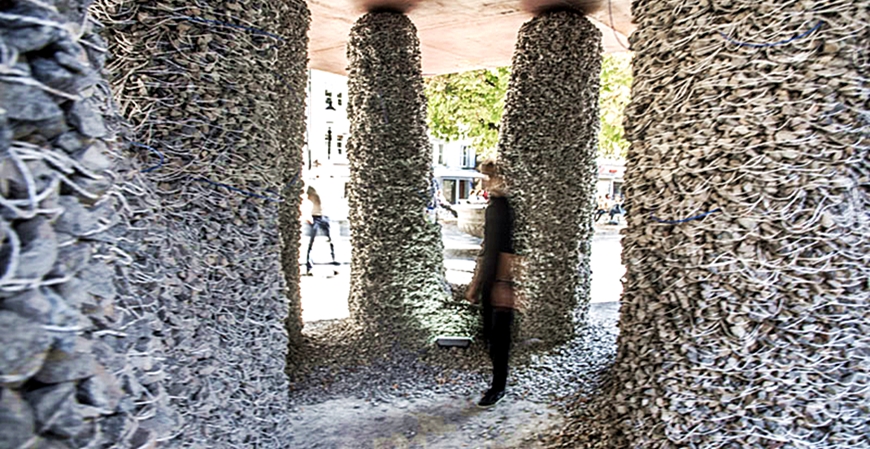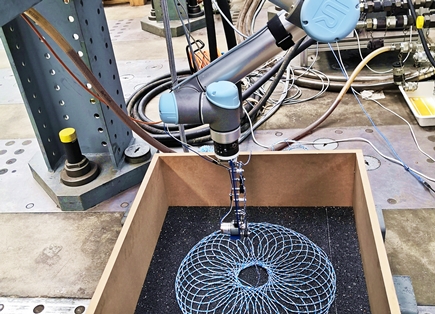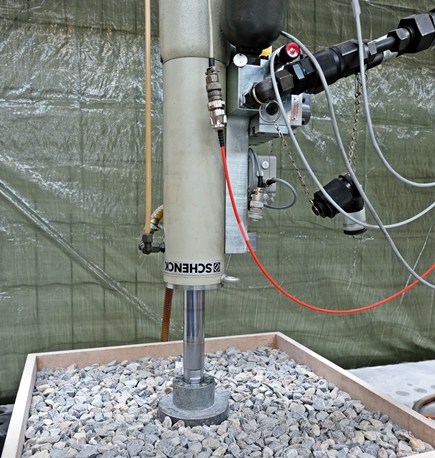Digitalized road construction
Knitting roads
Empa scientists are investigating how roads could be reinforced with simple means and recycled easily after use. Their tools are a robot and a few meters of string.

A robotic arm lays out a string in a mandala-like pattern on a bed of gravel. What appears to be a contemporary art performance is basic research that explores new ways in road construction. On the one hand, robot-assisted construction techniques for road building are being tested that have so far only been used in structural engineering. On the other hand, a new type of mechanical reinforcement is intended to change the typical structure of the road surface and thus to help save valuable resources in future or even to recycle road surfaces altogether.
An idea from structural engineering

The idea originates from a project of the Gramazio Kohler Research lab at ETH Zurich. Here the project was actually raised as an art and research project. Pillars piled up purely from strings and gravel demonstrated that outstanding stability can be achieved by simply interlocking the gravel with a thread – without any cement as a binder! Laboratory tests showed that gravel pillars with a height of 80 cm and a diameter of 33 cm can withstand a pressure of 200 kN, which corresponds to a load of 20 tonnes.
Asphalt also consists of rocks of various sizes and a binder, bitumen. Thus Martin Arraigada and Saeed Abbasion from Empa's «Concrete & Asphalt» lab transferred this concept to road construction: "We want to find out how a recyclable pavement could be produced in the future. To do this, we are using digitalized construction methods in road construction for the first time," explains Arraigada.
A string-reinforced road surface that does not require bitumen promises a number of advantages. Since bitumen is extracted from crude oil, air pollutants are released during production and also later during use. What's more, it makes asphalt susceptible to cracking and deformation and, on top of that, impermeable to rainwater – this too could be overcome. For the researchers, it is also conceivable that rock could be used that is otherwise not suitable for road construction, but is less rare. Last but not least, the process allows for a rollable and recyclable pavement.
A string and loose gravel
The two Empa researchers are using various experimental setups to test solutions for the above-mentioned aspects. The robotic arm plays a central role. It places the string in a programmed pattern on the layers of gravel stacked on top of each other. For the mechanical tests, five of these layers of gravel and thread are placed on top of each other in a test box, with the floor of the box covered with a rubber mat that fixes the whole package to the ground. It simulates the deformable bed, to which the pavement is applied. The fact that the string is exactly the same as the one used by every Swiss citizen for bundling waste paper shows that Empa researchers are breaking completely new (and cost-effective) ground here.
Mechanical tests and computer modeling

The gravel-thread package is then loaded with a rotating plate and with pressure. This load test shows: By entangling the individual gravel stones with the thread, the package can withstand a pressure of 5 kN – half a tonne – without the stones moving much. Normally, the binder bitumen performs this task in asphalt. Dynamic load tests with rolling pressure, similar to the extreme conditions road pavements have to withstand, are soon to be carried out.
In parallel to their lab experiments, the researchers model everything in 3D on the computer using the Discrete Element Method (DEM). This should reveal the displacement of individual stones and the tensile forces acting on the thread – something that cannot be investigated in the lab. In addition, different patterns and mesh widths and their effects on the stability of the pavement will also be examined in more detail.
The research of Martin Arraigada and Saeed Abbasion has not yet resulted in a final product that is ready to be used in road construction. However, their research provides a lot of innovative potential to get closer to a recyclable and possibly rollable road pavement with simple means.
Further information on the topic is available at: www.empa.ch/web/s308

Autonomous driving
Vision test for autonomous cars
Cars that autonomously navigate from A to B are expected to be a common sight in a few years from now. But road approval is still a long way off. One important aspect: How can we tell a self-driving car has become "blind" with age, i.e., its sensors would need to be replaced? An Empa team is looking for a solution. (Image: Empa).
>>>>

Materials research
Voltage from the parquet
Researchers at Empa and ETH Zurich have made wood flexible and turned it into a micro-generator. When it is loaded, electrical voltage is generated. In this way, the wood can serve as a bio-sensor – or generate usable energy. (Image: istock).
>>>>

Methanization
Saving the climate with solar fuel
>>>>






